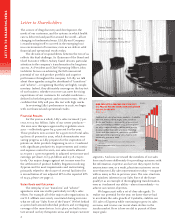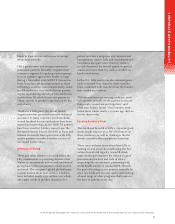Eli Lilly 2006 Annual Report Download - page 5
Download and view the complete annual report
Please find page 5 of the 2006 Eli Lilly annual report below. You can navigate through the pages in the report by either clicking on the pages listed below, or by using the keyword search tool below to find specific information within the annual report.
LETTER TO SHAREHOLDERS
3
In 2006, Cymbalta became one of only a handful of
products in our industry ever to reach $1 billion in sales
in its second full year on the market—$1.3 billion, to be
precise, nearly double its 2005 sales. Cymbalta benefi ted
signifi cantly in the U.S. from our direct-to-consumer
advertising campaign, which educated patients about a
range of depression symptoms, including the disease’s
emotional and painful physical symptoms. Cymbalta
outperformed all branded antidepressants in terms of
share-of-market growth in the U.S. during 2006. And
outside the U.S., Cymbalta experienced a series of ever-
more-successful launches, as measured by how quickly
we grew our market shares.
For Zyprexa, our largest product, 2006 marked a
turning point in the U.S. We stabilized prescribing levels,
which had been declining for the past several years. One
key element in our success is a focus on treating schizo-
phrenia and bipolar disorder in patients with the most
urgent needs, for whom Zyprexa’s value proposition is
unmistakable. Our sales representatives seek to provide
very practical assistance to doctors—helping them fi rst
to stabilize patients and then evaluate the tolerability,
safety, and effi cacy of treatment. Available to all patients
with mental illness, our Solutions for Wellness program
helps doctors to use diet and exercise as part of an overall
disease-management plan.
Outside the U.S., the impact of our wellness programs
and our leading share-of-voice among psychiatrists have
allowed Zyprexa to grow, or at least to hold its own, in
most of our major markets. In terms of volume growth
this year, Japan, Spain, and the United Kingdom stand
out with 14, 11, and 12 percent growth respectively—and
Japan in particular still has a lot of upside potential.
Late in 2006, the United States Court of Appeals
upheld an earlier ruling that had affi rmed Lilly’s patent
on Zyprexa. This legal development further increases our
confi dence that Zyprexa will remain a major contributor
to our sales results through 2011, when its patent expires.
We also entered into agreements with plaintiffs’ attorneys
at the start of 2007 to settle the vast majority of remain-
ing product-liability claims against Zyprexa.
Our record in meeting our key sales objectives in
2006 was not unblemished. We did not make the progress
we had hoped for in reaccelerating Lilly’s U.S. insulin
business. Our goal is to make Humalog the preferred
mealtime insulin brand. While its image among doctors
as measured in marketing surveys is moving in the right
direction, we believe we can and must do better. Early
in 2007, therefore, we increased our sales-force capacity
in diabetes care by 40 percent in the U.S., to boost our
market-share growth.
Progress in Diabetes Care
We are confi dent in the long-term success of our
diabetes business for three major reasons. First, Lilly’s
approach to the diabetes business is a global one—and
our investments refl ect that. Humalog sales, for example,
are growing not only in the U.S. but also in other major
markets. In 2006, we added 100 sales representatives to
our diabetes business in China to respond to the enor-
mous unmet need, doubled our diabetes sales force in the
U.K., and tripled our reach in Brazil.
Second, to an extent that we believe is unsurpassed
in the pharmaceutical business, Lilly’s products address
the full spectrum of diabetes care—and we are committed
to helping doctors understand the options. Our portfolio


















